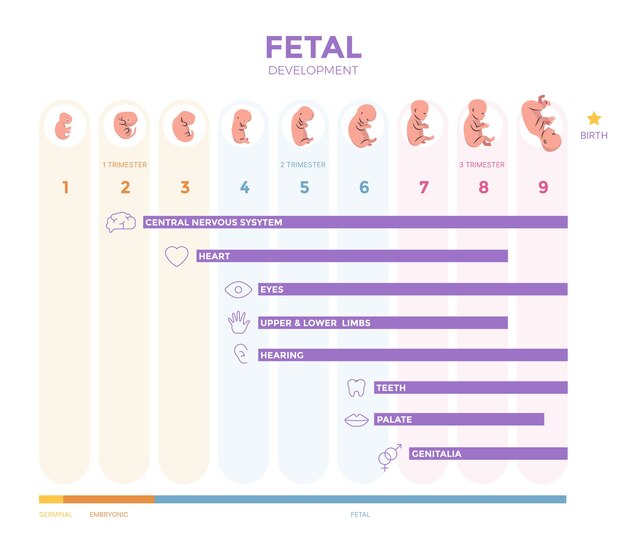
Pregnancy is an incredible journey for couples, filled with anticipation and preparation as labor approaches. While pregnancy itself can be complex, having twins adds an extra layer of intricacy. Carrying twins involves unique differences in fetal development that parents should understand and discuss to be emotionally and physically prepared. Every week of a twin pregnancy can bring new experiences, with some being calm and others eventful. Here’s a clear week-by-week guide for those expecting twins.
### First Trimester: Weeks 1-13
The first trimester is often the most challenging, especially with twins. Due to higher levels of the hormone hCG, symptoms like nausea and fatigue can be more intense and may start earlier. Women carrying twins might notice pregnancy signs sooner than usual. A quicker positive result from a home pregnancy test, especially with diluted urine later in the day, could suggest twins. By six weeks, an ultrasound can confirm a twin pregnancy.
During this period, symptoms such as a rapidly expanding uterus, tender breasts, frequent urination, extreme fatigue, increased appetite, and heightened sensitivity to smells are common. Nonidentical (fraternal) twins originate from two separate fertilized eggs, while identical twins come from a single fertilized egg that splits into two.
Organ development begins early, with the neural tube forming into the brain and spinal cord by week four. Circulatory development starts around this time too, and tiny arms, legs, and facial features begin to take shape. By the end of the first trimester, organs like the liver, kidneys, and reproductive systems are developing rapidly.
### Common First Trimester Symptoms
Frequent challenges during this trimester include nausea, heartburn, nosebleeds, shortness of breath, tender breasts, fatigue, and changes in appetite. There may also be visible signs, including darkened areolas and a growing belly. On your first doctor visit, tests such as blood pressure checks, urine screening, and ultrasounds may be performed. It’s also a good time to discuss family and medical history with your doctor.
### Second Trimester: Weeks 14-27
The second trimester, often called the most enjoyable phase, is when many early symptoms subside. Morning sickness typically decreases, and energy levels improve, allowing expectant mothers to feel more comfortable and optimistic. Couples often feel a stronger attachment to their babies, especially as fetal movements become noticeable.
During this period, mothers might experience improved appetite, increased vaginal discharge, occasional headaches, or swelling in the feet and breasts. As the babies grow, symptoms like fatigue, backaches, and round ligament pain might emerge. The skin may darken in some areas, stretch marks may appear, and women may notice an unmistakable pregnancy glow due to increased blood flow.
Fetal development accelerates, with twins reaching approximately 4 inches in length and 120 grams by week 16. By week 20, they measure 10 inches and are making coordinated movements. Their skin develops protective layers like the vernix caseosa, and their auditory systems become more responsive, allowing them to sense vibrations.
### Ongoing Symptoms and Care
Symptoms such as heartburn, nasal stuffiness, leg cramps, anemia, fatigue, and round ligament pain may persist. During this time, continue regular checkups to monitor fetal growth, weight gain, and overall health. Doctors may conduct ultrasounds, family planning discussions, and screenings for potential conditions like preeclampsia or gestational diabetes.
### Third Trimester: Weeks 28-40
The third trimester marks the final stretch. With a considerably larger belly and growing discomfort, mothers may experience swelling, exhaustion, and frequent urination as the babies occupy more space. The physical and mental toll is more pronounced with twins, making rest and self-care essential.
By week 28, twins typically weigh about 2 pounds each and measure 15 inches in length. Organs continue maturing, and fat deposits improve their ability to regulate body temperature outside the womb. Movements become more restricted as space becomes limited. During this phase, symptoms like Braxton Hicks contractions, back pain, pelvic pressure, and overheating are common.
As labor approaches, the focus shifts to birth preparation. At around 36 weeks, twins typically weigh between 5.5 to 8 pounds each and measure approximately 20 inches in length. Doctors may recommend regular hospital visits to monitor labor signs and assess fetal positioning. Decisions regarding vaginal birth or a cesarean section are finalized during this period.
### Preparing for Birth
This period requires physical and emotional readiness. It’s crucial to monitor for preterm labor signs, stay hydrated, and follow medical advice closely. Regular doctor visits will include assessments of fetal heartbeats, fetal positioning, and ultrasounds. Mothers should also arrange post-birth plans and finalize essentials like baby care items.
### Conclusion
Welcoming twins into the world is a profound and miraculous experience. For mothers, staying physically and emotionally prepared ensures not only a healthy pregnancy but also a smoother delivery. With careful planning and support, the journey can be both fulfilling and rewarding, leading to the arrival of two beautiful new lives.